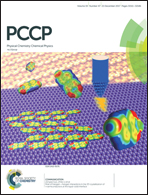Molecular insights into the enhanced rate of CO2 absorption to produce bicarbonate in aqueous 2-amino-2-methyl-1-propanol†
Abstract
2-Amino-2-methyl-1-propanol (AMP), a sterically hindered amine, exhibits a much higher CO2 absorption rate relative to tertiary amine diethylethanolamine (DEEA), while both yield bicarbonate as a major product in aqueous solution, despite their similar basicity. We present molecular mechanisms underlying the significant difference of CO2 absorption rate based on ab initio molecular dynamics simulations combined with metadynamics. Our calculations predict the free energy barrier for base-catalyzed CO2 hydration to be lower in aqueous AMP compared to DEEA. Further molecular analysis suggests that the difference in free energy barrier is largely attributed to entropic effects associated with reorganization of H2O molecules adjacent to the basic N site. Stronger hydrogen bonding of H2O with N of DEEA than AMP, in addition to the presence of bulky ethyl groups, suppresses the thermal rearrangement of adjacent H2O molecules, thereby leading to lower stability of the transition state involving OH− creation and CO2 polarization. Moreover, the hindered reorganization of adjacent H2O molecules is found to facilitate migration of OH− (created via proton abstraction by DEEA) away from the N site while suppressing CO2 approach. This leads us to speculate that catalyzed CO2 hydration in aqueous DEEA may involve OH− migration through multiple hydrogen-bonded H2O molecules prior to reaction with CO2, whereas in aqueous AMP it seems to preferentially follow the one H2O-mediated mechanism. This study highlights the importance of entropic effects in determining both mechanisms and rates of CO2 absorption into aqueous sterically hindered amines.



 Please wait while we load your content...
Please wait while we load your content...